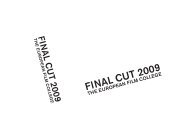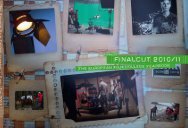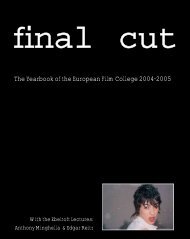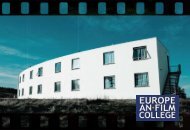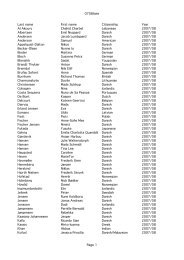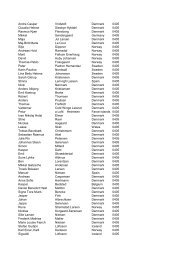yearbook 2004/05 - The European Film College
yearbook 2004/05 - The European Film College
yearbook 2004/05 - The European Film College
You also want an ePaper? Increase the reach of your titles
YUMPU automatically turns print PDFs into web optimized ePapers that Google loves.
<strong>The</strong> Duellists<br />
By<br />
Bue B. Petersen<br />
Emmanuel<br />
Dayan<br />
Keira Robertson<br />
Mads Grage<br />
Rosenkrantz<br />
Maria Lomholt-<br />
Thomsen<br />
Mofizur<br />
Rhaman<br />
FROM THE STUDENTS<br />
This text was produced by a group<br />
of students in Petru Maier’s course<br />
on Picture and Composition.<br />
<strong>The</strong> cinematography of<br />
the last duelling scene<br />
‘<strong>The</strong> Duellists’ is based on a story by Joseph<br />
Conrad, variously titled “<strong>The</strong> Duel” and “<strong>The</strong><br />
Point of Honour” (1908). D’Hubert (Keith<br />
Carradine) and Feraud (Harvey Keitel) are officers<br />
in Napoleon’s army and they spend their<br />
off-hours challenging each other to bloody duels.<br />
This goes on for many years with neither<br />
man showing any inclination of calling a truce.<br />
‘<strong>The</strong> Duellists’ was the debut feature from Ridley<br />
Scott and won the Cannes Prize for ‘Best<br />
First <strong>Film</strong>’.<br />
<strong>The</strong> film can be seen as an effort to return to<br />
the golden age of visual representation: romanticism<br />
and academicism.<br />
An important fact concerning the historical<br />
setting of the film is the duplicity of the relationship<br />
of the aristocracy to Napoleon in those<br />
times: <strong>The</strong> success of Napoleon during this period<br />
was the occasion for the old principles of<br />
aristocracy to affirm themselves strongly against<br />
the egalitarian principles of the revolutions and<br />
for the apparition of a new class of rational noblemen<br />
who were ready to adapt themselves to<br />
Napoleon, or any new power that came their<br />
way.<br />
<strong>The</strong> two characters have a duel because one<br />
is still into duels and the other is not. But<br />
somehow they can’t manage to kill each other,<br />
though they have a lot of occasions to do so.<br />
As the main character, D’Hubert, loses the belief<br />
in the meritocratic order, his first love, and<br />
his physical ability, the audience has the feeling<br />
that he is caught up in Feraud’s game. D’Hubert<br />
goes to the point of secretly saving his life and<br />
the spectator is given a hint that it is to have<br />
another occasion to kill him within the ritual<br />
of the duel.<br />
<strong>The</strong>refore, the tension that nourishes this duel<br />
scene is double. <strong>The</strong> questions are:<br />
• Who will end up killing the other?<br />
• Whether D’Hubert will surrender in more<br />
general, underlying conflict, which takes place<br />
between the principles of rationality and the old<br />
codes of manly honour?<br />
We chose to analyze the sequence of the last duel<br />
because it represents the two questions mentioned<br />
above. <strong>The</strong> tension of the fight builds<br />
into another tension; will D’Hubert stick to<br />
his contempt of duelling? Has D’Hubert been<br />
used up and transformed by this life of losses<br />
and duels or is he still the same character as in<br />
the first scene?<br />
<strong>The</strong> last duelling scene represents the cinematography<br />
we see throughout the whole film<br />
very well. <strong>The</strong> cinematography of this sequence<br />
is characterized by beautiful steady shots that<br />
make one think of the oil paintings of the 18th<br />
century. Part of the duelling scene is shot with<br />
hand-held camera and the spectator gets the<br />
feeling of seeing the duel through the eyes of<br />
one of the duellists. This happens in the earlier<br />
duel scenes as well.<br />
<strong>The</strong> sequence opens with a wide shot of a grey,<br />
frosty landscape. D’Hubert walks towards the<br />
camera on a gravel road framed win the centre.<br />
His black coat forms a strong contrast tot the



